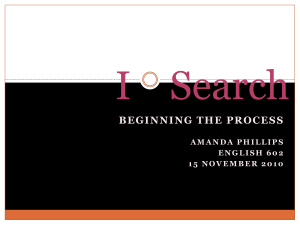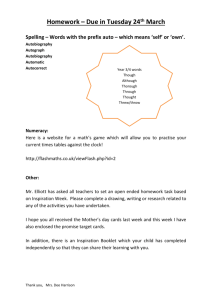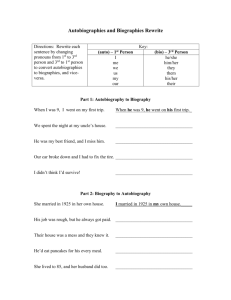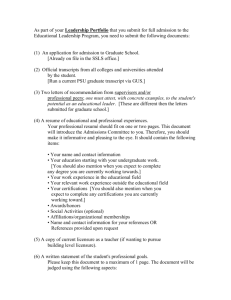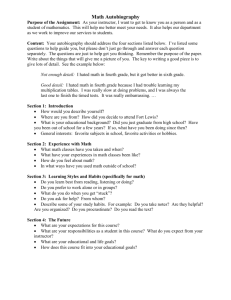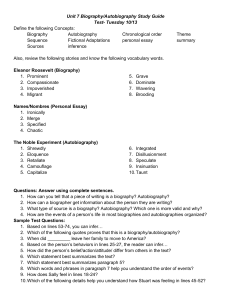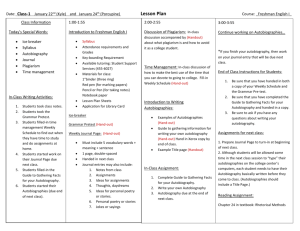Autobiographies When a person writes the story of his or her own
advertisement
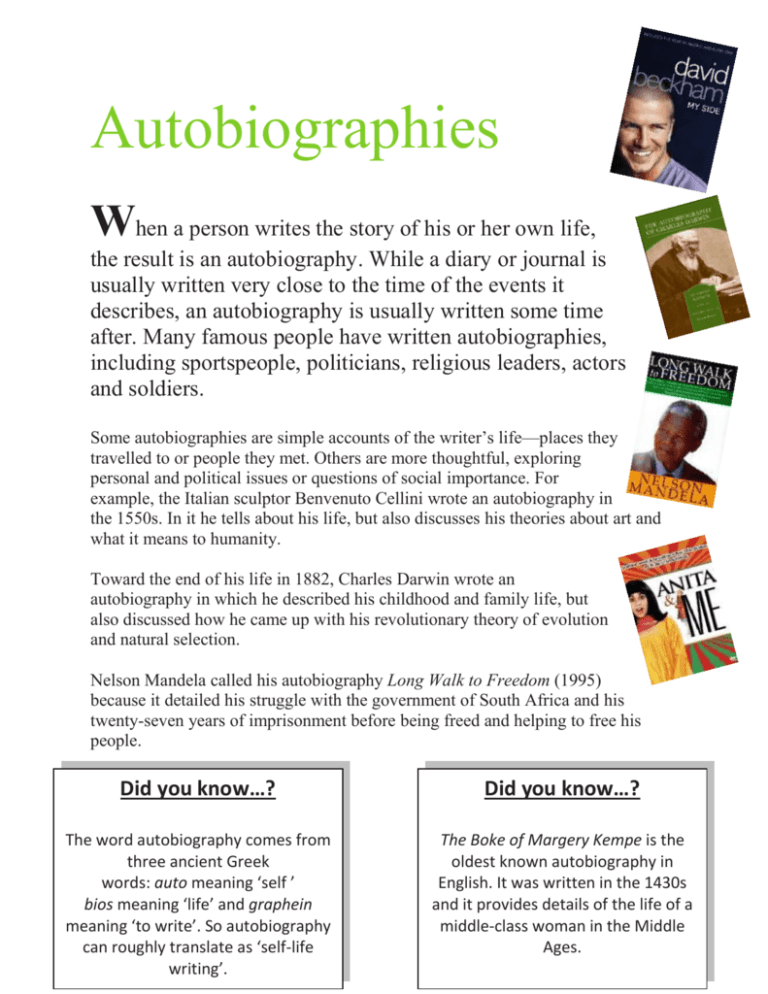
Autobiographies When a person writes the story of his or her own life, the result is an autobiography. While a diary or journal is usually written very close to the time of the events it describes, an autobiography is usually written some time after. Many famous people have written autobiographies, including sportspeople, politicians, religious leaders, actors and soldiers. Some autobiographies are simple accounts of the writer’s life—places they travelled to or people they met. Others are more thoughtful, exploring personal and political issues or questions of social importance. For example, the Italian sculptor Benvenuto Cellini wrote an autobiography in the 1550s. In it he tells about his life, but also discusses his theories about art and what it means to humanity. Toward the end of his life in 1882, Charles Darwin wrote an autobiography in which he described his childhood and family life, but also discussed how he came up with his revolutionary theory of evolution and natural selection. Nelson Mandela called his autobiography Long Walk to Freedom (1995) because it detailed his struggle with the government of South Africa and his twenty-seven years of imprisonment before being freed and helping to free his people. Did you know…? Did you know…? The word autobiography comes from three ancient Greek words: auto meaning ‘self ’ bios meaning ‘life’ and graphein meaning ‘to write’. So autobiography can roughly translate as ‘self-life writing’. The Boke of Margery Kempe is the oldest known autobiography in English. It was written in the 1430s and it provides details of the life of a middle-class woman in the Middle Ages. Writing You Own Autobiography Over the next few weeks you should try to read the series of extracts from the autobiographies of famous comedians, sports personalities, TV presenters and authors. All of these extracts will be available on the VLE and most of the book from which they are taken are available in the school library. When you have read each extract you may wish to do further internet research or you may be asked to think about specific things that the writer has used that you might be able to apply to your own writing. At the end of the project, your aim is to have several pieces of writing that will form chapters for you own autobiography. You should try to work on one piece of writing per week, redrafting and improving your work. There will be seven tasks in total one of which will run throughout the course of the project. This will be the last task on the list and you should aim to spend 10 – 15 minutes per week on this. You autobiography chapters will be based around the following headings: Beginnings Early childhood A special person A special place A significant memory Hopes and ambitions for the future My life in pictures. In the first week of the project you will given three extracts to read and three tasks to try to complete. Following this there will be one new extract and one new task per week as well as the multi-media ‘My life in pictures’ which can be completed at any stage during the project. Use the extracts and the prompts to help you tackle these tasks. Of course, your English teacher will be there to offer help and advice if you need it. How you present your work will be entirely your decision. You may wish to word process your chapters or handwrite it neatly and hand it in as a booklet. You could also add pictures or photographs to your work. The final project should be handed in to your English teacher on 4th April 2014. Beginnings Read the extract from children’s author Jacqueline Wilson’s autobiography ‘Jacky Daydream.’ In this extract Wilson describes the moment she was born and the first few days of her life. Wilson starts this chapter with ‘I was more than a fortnight late for my own birth.’ Obviously, she wouldn’t have known this herself; she must have taken the time to find out details about her mother’s experience. Notice how Wilson writes in the first person (using the word I). Even though she could not recall the thoughts and feelings that she would have experienced as a baby, she still writes as if she remember what happened in detail. Wilson would have had to ask lots of questions about her birth so that she could write in such detail. Tasks Write a list of questions that you would like to know about the day you were born. Ask your parents if you can interview them. You may wish to record this on a tape recorder or find some other way of taking notes. Can you find and include a photograph of you as a baby? Write the first section of your autobiography. Use the Jacqueline Wilson extract to help you. Remember to write in the first person and try to include interesting details. Don’t forget to redraft and improve your writing. Check you work and ask yourself how it could be better! Early Childhood Read the extracts entitled ‘The Bicycle and the Sweet Shop’ and ‘The Great Mouse Plot’ from Roald Dahl’s autobiography Boy: Tales of Childhood. In this extract Dahl describes some key memories from his early childhood. Notice how Dahl includes speech in these extracts as a method of keeping the reader interested in his story. He breaks the narrative voice and introduces the voices of other characters from his childhood to engage the reader further and make us more involved in the story. He also exaggerates stories and characteristics of particular people to create humour for the reader. Writers have to use specific rules when using speech in writing, particularly when there is more than one person talking, as it can sometimes get confusing. The use of paragraphing is particularly important as well as the use of speech marks and commas. Tasks Research/revise the rules about using speech in writing. Find out how to use paragraphs, speech marks and commas precisely when writing speech. Think of a story from your early childhood Write the next section of your autobiography which should be a memory from your early childhood. Try to include speech and exaggeration in this section. Remember! Things can always be better. Don’t forget to check your work! Save your draft and include them in your project. A Special Person Read the extract from Maya Angelou’s autobiography I Know Why the Caged Bird Sings. In this extract Angelou describes her brother Bailey, both physically and the connection she felt for him emotionally. Notice the tone of admiration that comes across in this extract. Angelou uses lots of similes and metaphors in this extract to describe her brother. Again, she uses lots of detail in her portrayal of Bailey. In the last few sentences of hits extract, she explains the emotional connection she had with her brother and emphasizes how important he was in her life. Tasks Think of a person who has played a really important part in your life so far. Think about the reasons why you admire and respect them. Are there any stories that you could use that shows your special bond with this person? How would you describe them physically? Write your next section of your autobiography, which should be about a person who is important to you. Try to include metaphors, similes and interesting adjectives in this section of your project. Keep redrafting! Make it better than it already is! A Special Place Read the extracts from Laurie Lee’s Cider With Rosie where he vividly describes two places that he remembers from his childhood. These places must have had a huge impact on his younger years since he remembers them in such detail all these years later. Look especially at the way he uses lists to build up a montage of sounds, sights, smells and memories. Notice he uses different types of punctuation to build lists, including commas and semi-colons ( the ; symbol) and full-stops to add particular emphasis. Semi-colons are particularly good for building lists within lists, adding rich layers of detail to the scene he’s describing. Note also how Lee uses poetic techniques like repetition, alliteration, and onomatopoeia. A particularly inventive thing about Lee’s writing is how he uses poetric rhythm and rhyme at times as well. Can you spot a place where the words seem to read more like a poem? Tasks Try and think of some places that evoke particularly strong memories – good or bad. (Home, school, relative’s house, holiday place, social place – somewhere you can describe in detail) Are there any stories connected with the place you can tell, or work in to your description to create atmosphere? Use all your senses. Think about not just what the place looked like, but the other features, smells, sounds, tastes and feelings. Use a thesaurus to help expand the range of words you use, think about them – which ones sound best to you? As you write this section, have a go at building up detailed descriptive lists using a range of punctuation, including semi-colons. Experiment with poetic techniques like repetition, rhythm and I’m still here! Make sure you still keep onomatopoeia. Take risks! You can always redraft. improving your work. A Significant Memory Read the extract from Alan Carr’s autobiography Look Who It Is where he desribes the first moment he went on stage to perform live stand up comedy. Alan Carr desribes his mixture of emotions at this point in his story and tells us his personal thoughts about this exciting event in his life. Notice how Carr uses a short sentence and the end of his extract to create an impact and emphasise it meaning. In fact, this line is given a whole paragraph to itself which further emphasises it. Tasks Think of an important moment in your life that you think might have an impact on something you do in the future. Write the next section of your autobiography where you desribe this memory and the feelings you experienced at the time. Try to use a short sentence for impact in this section. Keep redrafting… Hopes and Ambitions Read the extract from Alan Sugar’s autobiography What You See is What You Get. In this extract Alan Sugar desribes the moment he decided to start working for himself and explains how he got to be in the position he is now. Task Think about your hopes and ambitions for the future. Where do you hope to be in 15 years time? Project yourself into the future and imagine that you have achieved everything you set out to achieve. When you write this section of your autobiography you will have to imagine that you are writing it as an adult who is nearly 30 years old. In this section you need to explain the first step you took to making your hopes and dreams for the future come true. Zzzzzzzzzzzzzzzzz… My Story In Pictures Look at the comic book style illustrations that have been used to convey information quickly, in an interesting way. Choose which task you carry out. This will complete your project. Either: Produce a illustrated version of your life story so far (or you could use photographs if you prefer) ensuring that you add the correct text to your pictures to explain them. Or Turn your autobiography into a multimodal autobiography. Use multimedia software to create a slideshow with voice-over narration and music. You could use photos from home, voice clips from friends and family and music that you associate with special events in your life.

